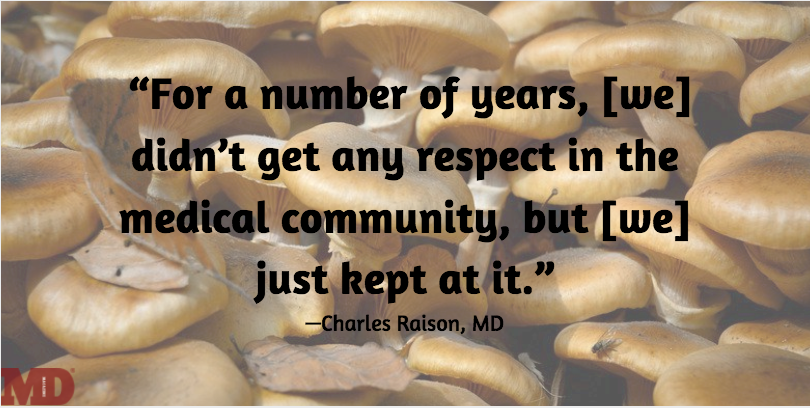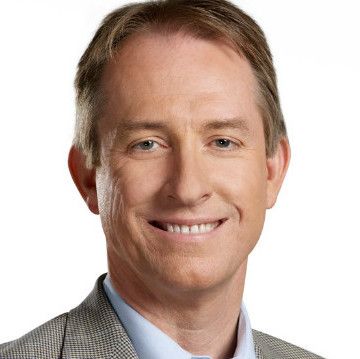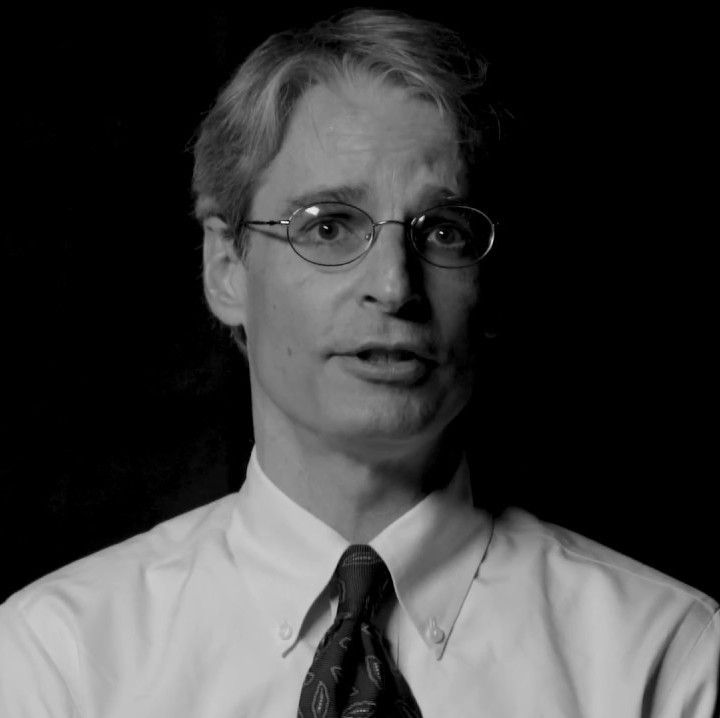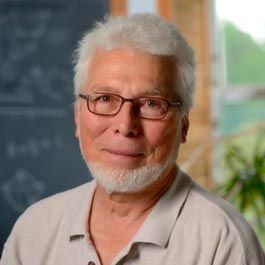Running Away or Righting The Way: Is Psilocybin a Viable Psychiatric Treatment?
Following decades of research prohibition, physicians are once again raising the psilocybin question. This time, they’re letting data define the answer.

Richard Cone was going to die, just like everybody else. But unlike most, he could foresee his moment of passing. It was coming in 2, maybe 3 more years—at least that’s what his oncologist said.
Cone had just been diagnosed with metastatic prostate cancer. The burden of disease was only exceeded by the excruciating awareness that before very long, he’d meet his untimely end. Following his diagnosis, he lacked the desire or energy to get out of bed. His only motivation to go on living was spurred by the shoddy hope that return visits to the oncology department might produce some new and unexpected breakthrough.
And one day, they did. Following a treatment session, his oncologist approached him with a small pamphlet, only a few pages long, and placed it in his hand. On the cover, Cone read the words, “Coping with Cancer.” There was an opportunity within the folios, his doctor said.
Cone wasn’t convinced. “I had already coped with cancer,” he told MD Magazine. He had lost his 8-year-old daughter Tanya to the disease and was just beginning to move on before the condition began to haunt him, too.
At first, he spurned his doctor’s pamphlet. But as time passed, depression continued to weigh on him. Finally, he picked it up, opened the cover, and was met with something extraordinary. “The first picture inside was of a mushroom. I guessed right away [what it was],” Cone said.
The pamphlet called for volunteers who were depressed and had incurable conditions to enroll in a clinical trial of psilocybin, the psychoactive ingredient found in some mushrooms. It was a trial led by Roland R. Griffiths, PhD, a world-renowned professor of psychiatry at Johns Hopkins, known widely for his work with mood-altering drugs.
A HISTORY OF PSYCHEDELICS IN PSYCHIATRY

Charles Raison, MD
“I was low-grade, but continuously, depressed. I had an incurable condition. This was for me,” Cone said.Psilocybin is one of several psychedelic drugs that has been studied by physicians for its effects on mood, depression, and trauma. Along with methylenedioxymethamphetamine, commonly known as MDMA, and a few others, it has been periodically involved in clinical research as far back as the 1950s.
But in the 1970s, right around the time that clinical trial design began to be more closely reexamined to include placebo controls, blinding, and randomization, these drugs were rescheduled by the United States government to their current designation: Schedule I, no value.
“You have this mountain of studies until about 1970, and then it stops. All human studies stopped, so there were just ongoing animal studies that were trying to understand their abuse liability,” said Charles L. Raison, MD, professor in the School of Human Ecology at the University of Wisconsin-Madison. “There was a hiatus of 26 or 27 years where research was just killed, and when it started again there were significant difficulties and significant pressure. It was really a challenge.”
Had psychedelics been available to study in the 1980s when modern pharmacology started to take off, people would have studied it, Raison said. Physicians and scientists would have been able to push harder to pursue them for an indication. “I’m almost certain that we’d be in a totally different world,” he said.
Absence of clinical evidence soon became a compounded issue. When there’s no research, attention tends to wane. Not only do clinical trials stop, but meta-analyses and trial reviews cease too. As a result, physician awareness and interest in exploring novel psychedelic therapies dwindles.
“Generally, when you read the reviews, the literature was given a very short shrift, and shown to be ineffective,” said Mike Bogenschutz, MD, professor of psychiatry at New York University School of Medicine. “But when you go back and look, [several trials] found that, in fact, there was a robust effect of psilocybin over control treatment at the first follow-up and it persisted for at least 6 months.”
That evidence alone is strong enough to warrant continued studies on psychedelics, he said.
DON’T RUN AWAY, RIGHT YOUR WAY
Following the revelatory moment spurred by his oncologist’s pamphlet, Cone enrolled in Griffiths’ trial. As if to make up for the decades-long research drought, Griffiths’ team worked to gather as much concrete and objective data as possible. For Cone, the process was arduous.
“After the dose, they ask you to sit down and write a report, which was helpful for both me and them,” he said. “They don’t know what’s going on inside me, so the reports really cemented the memory. It’s sort of like dream—if you write them down right away, you can capture them. I still have the reports. I look at them occasionally.”
Before his first double-blinded session with psilocybin, he spent time getting to know his “guides,” the physicians who attended to him during his sessions. They would need to be comfortable with each other, they said. If Cone were ever to become afraid or begin experiencing trouble, the guides would be there to help him through it.
“There was one point where I was both moved and afraid, and they sat on either side of me and just held me,” Cone said. “They didn’t say anything, they just held me, and I calmed down and continued. When I was not progressing rapidly, on a couple occasions, they would break in with guided imagery, which really helped unlock me on a few occasions.”
One of Cone’s guides was Bill Richards, MD, a psychologist at Johns Hopkins. Cone said Richards gave him important advice: “If in the middle of your trip, a dragon comes at you with huge jaws and teeth, bellowing fire and fumes, right your way, don’t run away. Ask the dragon what it wants. It’s your unconscious making this dragon.”
“My unconscious is pissed because I’m ignoring something,” Cone said. “It’s a clear example of the editing function of our brains, which filters our subconscious, being relaxed. Out comes this great frustration.”
Raison said that patients often confront their demons—or dragons—in these sessions. It can bring on intense feelings of liberation, he added, because it helps them feel as if they’ve mastered something, or moved beyond a hurdle that was holding them back.
Cone’s dragon was the grief that surrounded his daughter’s death. In his first session, he found himself thinking of Tanya. He had grieved when she got cancer and done his best to cope with her death. But now he found himself grieving and coping all over again. It always seemed to come back to Tanya.
“I thought I had done my grieving, but on that first trip, as I got into it, it reemerged,” Cone said. “I re-experienced the intensity and profundity of the grief that I felt in the immediate aftermath of her death, and I let myself feel that grief even more intensely than I had.”
Laying on a sofa in a living room filled with the soft sounds of classical music, Cone found himself sobbing and howling over his daughter’s death, an event that had passed decades ago.
DATA AS FUEL

Michael Bogenschutz, MD
“When my wife came back into the room afterward, I told her that I had gone through this intense grieving episode, but she said that I seemed very happy,” he said. “I was. I had stored up, for 25 years, some yet-to-be-resolved grief. [When I let it go,] I felt better. I really felt the intense grief, and that was useful.”Since the 1970s and 80s, a slow crawl back to the clinical understanding of psychedelics has been gaining momentum. In the mid-1990s, Rick Strassman, MD, conducted a dimethyltryptamine (DMT) study in New Mexico. In Switzerland, Franz Vollenweider, MD, began trials following in the footsteps of research from the 1960s, with the hypothesis that therapies could be models for psychosis.
Then, in the 2000s, Griffiths began exploring the effectiveness of psilocybin for treating patients with depression, anxiety, and other conditions. “Roland and his crew began doing careful studies and normal controls that showed that it was safe, people did not freak out, and it had beneficial effects on personality,” Raison said.
Institutions like the Usona Research Institute, where Raison is the director of clinical and translational research, and the Multidisciplinary Association for Psychedelic Studies (MAPS), where he works as a scientific advisor, and the Heffter Institute, which funded both Griffiths' study and a study on addiction and psilocybin conducted by Bogenschutz, have spearheaded studies and clinical examinations of these drugs. Raison likened his organizations to nonprofit pharmaceutical companies that have been effective in acquiring funding for trials from donations and grants.
Bogenschutz has been spearheading clinical research in alcohol and drug use for 2 decades but was not particularly involved with psychotherapy to start.
“I didn’t know that anyone was giving psilocybin to people in clinical settings,” Bogenschutz said of the recent trials. “Turns out that under carefully controlled conditions, it appears to be safe and well tolerated and cause very minimal persistent adverse effects. For very many people it appears to be, in their estimate, a very positive experience.”
One of the trials that caught his eye was Griffiths’. Another, in 2012, was a meta-analysis that combed through older trials to determine which had produced results that could be deemed statistically significant and clinically relevant based on the standards of modern trials.
“When the results were pooled in that meta-analysis, they were statistically and clinically significant, with an odds ratio close to 2 in favor of [the therapy],” Bogenschutz said. “That’s more effective than any FDA-approved treatment for alcoholism.”
Raison, likewise, has been a well known psychiatric researcher for some time, but has been involved in psychedelic and psychoactive research now for just about 3 years. While public perception has become more progressive, he admits that the war on drugs still has an impact on how their clinical use is understood.
“It’s interesting. There are some leading institutions that are very much opposed to this work, actually, and then, on the other hand, there are some leading institutions in the United States that are all about it,” Raison said. “If you look at the places that are doing psilocybin work, they are not second rate. They’re Yale, Johns Hopkins, the University of California at San Francisco, and NYU. These are top, top places, all of which [Usona] are actively involved with.”
Both Raison and Bogenschutz agreed that more data is the key to convincing skeptics in the medical community that these therapies are valuable. Physicians are, after all, largely data-driven decision-makers, Bogenschutz said.
TEMPERING EXPECTATIONS
New data is already telling a compelling story and the powers that be are tuned-in. In August 2017, the US Food and Drug Administration (FDA) granted MDMA a Breakthrough Therapy designation—a huge step for the psychedelic class of drugs.Raison admits that as a researcher, he tends to be “out on the far edge of things.” But with his involvement in the study of psychedelic therapies, he’s become used to—and even welcomes—skepticism.
“I would start something, and people would look at me like I was crazy, and then it would be a couple years [later] and people would be looking at me like I was innovative, then maybe another couple years and it would be obvious what I was doing,” he said. “For a number of years, [we] didn’t get any respect in the medical community, but [we] just kept at it.”
Raison and Bogenschutz agree that it’s not the skeptics that scientists should worry about. Rather, those in favor of the therapies’ approvals are more likely to clog their progress through the pipeline.
“People are so desperate for treatments for things like PTSD [posttraumatic stress disorder] and depression that they are now overselling these treatments,” Raison said. “We haven’t even done the studies yet and they’re being sort of enthroned in heaven as what’s going to be the answer to all of our troubles—which I can promise is not true.”
The truth is that these treatments—just like any other novel therapy—carry risks and rewards. There have been tragic outcomes associated with illicit psychedelics, Bogenschutz said, but that risk can be mitigated or avoided in controlled settings.
“You give a talk and there will be some people who have an entrenched belief that these are dangerous and using them therapeutically is crazy,” Bogenschutz said. “Then there are people who are critical of the war on drugs, and maybe are enthusiastic about potential benefits of psychedelics and want to believe they’re magic cures—and they’re not.”
A SECOND CHANCE

Richard Cone, PhD
Most people, Bogenschutz hopes, will let the evidence speak for itself, and come down somewhere in the middle.After his daughter died, Cone dreamed that she became a Buddha. When he awoke, he bought a small Buddha statue to symbolize her memory.
For his second session in the trial, Cone’s guides asked him to bring in an object that was important to him. Naturally, he brought the Buddha. “Richards asked me to consider the Buddha. At the time, I was [able to] view it from an angle I’d never looked at it from,” Cone said. “I stroked its cheek, and [the Buddha] leaned into it, like a cat would. It was animated, and that was a real pleasure. Other things in the room become animated, too. They were not rigid and unchangeable.”
Cone’s depression began to lift, and by the end of the trial, he felt like a new person. The psychedelic therapies helped him confront his demons and properly grieve, he said, for both himself and his daughter.
Years after the trial, Cone’s cancer is now under control. There’s no evidence to suggest that it should be tied to his participation in psychedelic therapy, but the fact remains that psilocybin helped Cone open the door to a new life. “It’s like I’m realizing I am alive and OK,” he said. “I’d like to live life fully and enjoy it, and to be depressed is no way to do that. I feel free to enjoy it and to not be depressed. It was transforming.”
Cone’s oncologist only recommended the trial after he had exhausted his clinical treatment options over a course of 3 years. Whether for personal or scientific beliefs, he wasn’t confident that psychedelic therapy would be useful. The skepticism is warranted, Cone said, but it speaks to the struggles Raison, Bogenschutz and countless other researchers are up against.
Cone speaks about his experience freely. His memory of the time is vivid. Like many others who go through this type of experience, he says it was one of the most meaningful of his life.
“It’s a little like opening up the connections between unconscious and conscious, like putting aside the editing function of your brain. Everything that arises in our unconscious doesn’t emerge—somewhere in there is an editor. But this is like the editor gets relaxed. Not dismissed altogether, but more willing to let things happen,” he said.
With more research, the world may become willing to accept that psilocybin and other psychedelics have benefits that outweigh their risks, especially when delivered in a clinical setting. After all, Griffiths’ study—the one that changed Cone’s life—was a resounding success. In the trial, 80% of the patients maintained a positive clinical response up to 6 months after their dose was administered.
Video courtesy of the Heffter Research Institute.